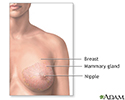Subareolar abscess
Abscess - areolar gland; Areolar gland abscess; Breast abscess - subareolar
Subareolar abscess is an abscess, or growth, on the areolar gland. The areolar gland is located in the breast under or below the areola (colored area around the nipple).
Abscess
An abscess is a collection of pus in any part of the body. In most cases, the area around an abscess is swollen and inflamed.
Causes
Subareolar abscess is caused by a blockage of the small glands or ducts below the skin of the areola. This blockage leads to infection of the glands.
This is an uncommon problem. It affects younger or middle-aged women who are not breastfeeding. Risk factors include:
- Diabetes
- Nipple piercing
- Smoking
Symptoms
Symptoms of an areolar abscess are:
- Swollen, tender lump beneath the areolar area
- Drainage and possible pus from this lump
-
Fever
Fever
Fever is the temporary increase in the body's temperature in response to a disease or illness. A child has a fever when the temperature is at or abov...
 ImageRead Article Now Book Mark Article
ImageRead Article Now Book Mark Article -
General ill feeling
General ill feeling
Malaise is a general feeling of discomfort, illness, or lack of well-being.
Read Article Now Book Mark Article
Exams and Tests
Your health care provider will perform a breast exam. Sometimes an ultrasound or other imaging test of the breast is recommended. A blood count and a culture of the abscess, if drained, may be ordered.
Ultrasound
Ultrasound uses high-frequency sound waves to make images of organs and structures inside the body.

Treatment
Subareolar abscesses are treated with antibiotics and by opening and draining the infected tissue. This can be done in a doctor's office with local numbing medicine. If the abscess returns, the affected glands should be surgically removed. The abscess can also be drained using a sterile needle. This is often done under ultrasound guidance.
Outlook (Prognosis)
The outlook is good after the abscess is drained.
Possible Complications
Subareolar abscess may return until the affected gland is surgically removed. Any infection in a female who is not nursing has the potential to be a rare cancer. You may need to have a biopsy or other tests if standard treatment fails.
When to Contact a Medical Professional
Contact your provider if you develop a painful lump under your nipple or areola. It is very important to have your provider evaluate any breast mass.
References
Dabbs DJ, Weidner N. Infections of the breast. In: Dabbs DJ, ed. Breast Pathology . 2nd ed. Philadelphia, PA: Elsevier; 2017:chap 3.
Gollapalli V, Liao J, Dudakovic A, Sugg SL, Scott-Conner CE, Weigel RJ, eds. Risk factors for development and recurrence of primary breast abscesses. J Am Coll Surg . 2010;211(1):41-48. PMID: 20610247 www.ncbi.nlm.nih.gov/pubmed/20610247 .
Hunt KK, Mittendorf EA. Diseases of the breast. In: Townsend CM Jr, Beauchamp RD, Evers BM, Mattox KL, eds. Sabiston Textbook of Surgery . 20th ed. Philadelphia, PA: Elsevier Saunders; 2017:chap 34.
-
Normal female breast anatomy - illustration
The female breast is composed mainly of fatty tissue interspersed with fibrous or connective tissue. The circular region around the nipple is often a different color or pigmented. This region is called the areola.
Normal female breast anatomy
illustration
Review Date: 10/4/2016
Reviewed By: John D. Jacobson, MD, Professor of Obstetrics and Gynecology, Loma Linda University School of Medicine, Loma Linda Center for Fertility, Loma Linda, CA. Also reviewed by David Zieve, MD, MHA, Isla Ogilvie, PhD, and the A.D.A.M. Editorial team.

